Physical Address
304 North Cardinal St.
Dorchester Center, MA 02124
Neuroendocrine tumors (NETs) are grouped together based on common “neuroendocrine” morphological features and the finding of intracellular ultrastructural neurosecretory granules whose presence is detected today mainly by immunohistochemistry (IHC). There has been movement toward uniformity of nomenclature within these tumors throughout the body, especially within the gastrointestinal tract and pancreas. This has resulted in grading schema that incorporate low-grade, intermediate-grade, and high-grade NETs. However, in the lung, the terminology remains carcinoid, atypical carcinoid, large cell neuroendocrine carcinoma (LCNEC), and small cell carcinoma as that is what is used in the current International Association for the Study of Lung Cancer/World Health Organization (IASLC/WHO) classification. ,
It is acknowledged that the neuroendocrine neoplasia nomenclature divides tumors into G1, G2, and G3 categories which may align with carcinoid (G1) and atypical carcinoid (G2). A G3 category may be emerging with the description of carcinoids with increased mitotic activity in the low range of LCNEC. However, the differences between small cell carcinoma and LCNEC from a clinical, pathologic, and treatment standpoint warrant their separation, despite having in common high-grade neuroendocrine carcinoma histology.
The origin of these tumors remains a topic of discussion. The earliest investigations of scattered cells within secretory mucosa of the gastrointestinal tract had in common the recognition that there were cells within the mucosa oriented away from the lumen and identifiable through histochemical reactions with silver salts. These first observations raised issues as to the possibility of secretion into the vasculature rather than the luminal space, and allowed for a method of detection in various organs. These cells were given different names including enterochromaffin, argentaffin, and Kulchitsky cells based on their staining characteristics and the histologist who studied them. Oberdorfer coined the term Karzinoid tumoren and Masson raised the possibility that these tumors were related to Kulchitsky cells with a secretory endocrine nature. Feyrter suggested that such cells were diffusely distributed among mucosal surfaces and introduced the concept of a diffuse neuroendocrine system. ,
Pearse and colleagues brought forth the concept that biochemical reactions in these cells—amine precursor update and decarboxylation (APUD)—were common to this cellular system and postulated a neural crest origin for these cells. However experimental evidence mounted that these cells were not of neural crest origin, and further studies showed that thyroid C-cells, melanocytes, myenteric plexus, and paraganglia were of neural crest origin, but not the neuroendocrine cells of various mucosal linings. It is postulated that these cells are derived from local precursors. However, the relationship of these cells to both epithelia and neural structures is a critical functional interface, and the spectrum of differentiation within these cells shows their own ability to straddle epithelial and spindle/neural-like differentiation.
Neuroendocrine cells are present in adult lung as scattered, mostly single cells, within large airway epithelium. These cells are thought to be important during lung embryogenesis and in fact are more plentiful in fetal lung. Achaete-Scute Family BHLH Transcription Factor 1 (ASCL1) expression, a transcription factor important for neuronal cell lineage commitment and differentiation, is critical to the generation of neuroendocrine cells.
Neurogenic differentiation 1 (NeuroD1) is also a bHLH transcription factor critical to neuronal development. Along with ASCL1, NeuroD1 has distinctive but important roles in neuroendocrine differentiation. In addition, Notch pathway inactivation is needed for normal neuroendocrine development, and this in part mediated by upregulation of Delta-like 3 (DLL3) via expression of ASCL1. These molecular relationships have led to insights into classification of small cell carcinoma.
The ultrastructural feature of neuroendocrine cells and tumors is the neurosecretory granule. Sometimes called dense core granules , these structures are round and characterized by an electron dense center surrounded by an outer membrane. They vary from 100 to 300 nm, and their number varies based on the grade of the tumor—more numerous in carcinoids and scarcer in small cell carcinoma. Because their detection requires electron microscopy, this approach has been largely replaced by IHC techniques that detect proteins associated with these dense core granules.
Chromogranins are proteins that are directly associated with dense core granules. As a result, their detection is most specific for the presence of these granules, but detection is dependent on the number of these granules within the tumor. Although both chromogranin A and chromogranin B can be present, the commonly used IHC assay targets chromogranin A. Therefore in addition to the number of granules present, the composition and balance between chromogranin A and B determines the sensitivity of this marker.
Synaptophysin is a membrane protein of 38,000 daltons that is associated with synaptic vesicles, both neuronal and neuroendocrine. In this regard this marker can be used to detect neuroendocrine differentiation, with the understanding that other cell types produce this protein. In practice, some tumors will produce synaptophysin without detection of chromogranin, although others chromogranin without synaptophysin. However overall, synaptophysin is more sensitive than chromogranin, and somewhat less specific. In one series 27% of morphologically squamous carcinomas and adenocarcinomas were synaptophysin positive, a finding common to other series. This indicates caution in using immunochemistry independent of morphologic assessment in the classification of tumors.
Neural cell adhesion molecule (CD56) is also a widely used marker as it is immunoreactive in a wide range of NETs. This is a cell membrane protein found in the nervous system, but also in neuroendocrine cells and tumors. Although the sensitivity of this marker is often highest among the commonly used neuroendocrine markers, nonneuroendocrine carcinomas may be positive for this protein, including ovarian stromal tumors, endometrial stroma sarcoma, synovial sarcoma, thyroid neoplasms, multiple myeloma, and natural killer cell tumors. This lack of specificity is a problem when CD56 is used in situations where morphological assessment is limited (small or crushed sample) or when tumors are sufficiently undifferentiated to require a broader differential diagnosis than carcinoma. In this regard, CD56 as a single positive marker among the three commonly used markers is most useful in well sampled and morphologically suspected NETs.
Insulinoma-associated protein 1 (INSM1) is a zinc finger transcription factor that is associated with neuroendocrine differentiation in a variety of organ systems and has emerged as a marker of neuroendocrine neoplasms. , Its sensitivity and specificity when compared to existing markers remains a topic of discussion, but large series demonstrate sensitivity and specificity that is equivalent or superior to existing markers in cytology, biopsy, and resection. It is especially helpful in high grade tumors. , Some have suggested a combination of INSM1 and CD56 to maximize sensitivity and specificity.
IHC as a technique has improved to include enhanced methods of antigen retrieval, antibodies effective in formalin fixed paraffin embedded tissues, and detection reagents developed to reduce background. Four markers—INSM1, CD56, chromogranin, and synaptophysin—have emerged as technically reproducible neuroendocrine markers. However, other antibodies have been used in the past. Neuron specific enolase is an enzyme found in neurons and neuroendocrine cells and for a time was the only consistent marker of neuroendocrine differentiation. Unfortunately, this protein may be found in combination with other proteins in its family, and these combinations may be found in other cell types. As a result, the most sensitive reagents will cross-react with many nonneuroendocrine tumors, and attempts to create more specific reagents have resulted in loss of sensitivity or technically difficult protocols. Protein gene product 9.5 (PGP9.5) is commonly expressed by neuroendocrine cells but also suffers from common expression in tumors without morphologic neuroendocrine differentiation or ultrastructural evidence of dense core granules.
The detection of specific peptides such as adrenocorticotropic hormone or calcitonin, although feasible, is generally relegated to situations in which tumors produce associated endocrine symptoms.
As a result of its documented importance in neuroendocrine cell differentiation, IHC for ASCL1 has been investigated in tumors. Although NETs are immunoreactive, a subset of nonneuroendocrine tumors are also positive for this marker. In addition, some cells that are synaptophysin positive are ASCL1 negative. Overall, although ASCL1 may be useful in determining cells that are destined to be neuroendocrine, its role in diagnosis remains uncertain. However, using this marker in the future classification of neuroendocrine neoplastic subtypes remains a topic of investigation.
IHC for DLL3 has been investigated for therapeutic reasons in small cell carcinoma but has not been established for routine diagnostic or predictive use. IHC to demonstrate loss of RB1 has also been advocated as evidence in support of high-grade neuroendocrine neoplasms but not achieved routine recommendation for use. Subclassification of small cell lung carcinoma may, in the future, incorporate IHC for ASCL1, NEUROD1, DLL3, RB1 and interestingly for cases in which neuroendocrine differentiation is not proved, YAP1 and POU5F; this remains to be established in future research as to its relevance to classification and therapy.
Diffuse idiopathic pulmonary neuroendocrine cell hyperplasia (DIPNECH) is currently defined by the 2021 WHO classification as “multifocal hyperplasia of pulmonary neuroendocrine cells associated with tumorlets.” This is a generalized proliferation of pulmonary neuroendocrine cells, scattered single cells, small nodules, or linear proliferations of pulmonary neuroendocrine cells that may be confined to the bronchial or bronchiolar epithelium. These can protrude into the lumen. Because DIPNECH is found in association with tumorlets and carcinoids, this definition goes on to include these entities. Carcinoid tumorlets are nodular proliferation of neuroendocrine cells, usually with an invasive growth pattern through airway wall, measuring 5.0 mm or less.
Neuroendocrine cell hyperplasia can be seen in association with a variety of chronic pulmonary conditions including infection, bronchiectasis, smoking-associated diseases, and high altitude, but DIPNECH itself is a bilateral condition which is considered a primary pulmonary process of neuroendocrine cell proliferation. The definition becomes increasingly complicated in settings where the background chronic lung disease can lead to histologic neuroendocrine hyperplasia, but where multi-focality cannot be assessed or when imaging or clinical manifestations are not present. This is compounded by publications of both symptomatic and asymptomatic presentations of DIPNECH.
DIPNECH syndrome or DIPNECH with airways disease has been proposed as the term to encompass patients with the combination of clinical, radiologic, and pathologic findings of the symptomatic disease. Patients with physiologic manifestations of airway obstruction as well as imaging associated with airways disease would be included, but incidental hyperplasia and hyperplasia associated with multiple nodules would not. These latter categories would be defined as secondary neuroendocrine cell hyperplasia and DIPNECH without airways disease, respectively.
DIPNECH as a pulmonary process associated with clinical obstructive lung disease was described in 1992 by Aquayo et al. in six patients in whom clinical and histologic findings characteristic of what has ultimately been classified under this term were found.
Patients with DIPNECH are usually women in their fifth or sixth decade, with an age range from mid-30s into mid-70s. Although it can occur in both smokers and nonsmokers, most series show a higher frequency of nonsmokers, largely never smokers. ,
Although not typically associated with tumor syndromes, it is of note that one reported patient had multiple endocrine neoplasia (MEN) type 1 syndrome, and that another had a pituitary adenoma which was not documented as being part of a syndrome.
Many patients are asymptomatic, but cough or increasing dyspnea may be present. In one review of 24 published cases, the majority were symptomatic, including cough, wheezing, or dyspnea. The proportion of asymptomatic patients varies by study and may reflect disease definition or study design; for example, one series divided patients based on symptomatic presentation versus imaging detection. In this series, age, gender, and smoking status was similar in both groups. One series comparing carcinoid tumors with and without DIPNECH as well as with pure DIPNECH cases encouraged use of the term only in the setting of symptomatic and radiologic findings, or alternatively, when associated with the histology of constrictive bronchiolitis. This is addressed in the WHO 2021 classification with criteria that lead to clinical or pathologic diagnosis of DIPNECH, and in pathologically defined cases a desired criterion for multidisciplinary examination to establish a clinicopathologic diagnosis of DIPNECH.
It is common for patients to carry a diagnosis of chronic obstructive pulmonary disease (COPD), asthma, or bronchiolitis prior to the definitive diagnosis of DIPNECH. Pulmonary function tests may demonstrate obstructive lung disease; this was seen in about 60% of patients; this also varies by series, including one in which all patients had obstructive physiology. In that series, over 50% of patients had oxygen desaturation to under 88% during a 6-minute walk test.
Cushing syndrome has been rarely described in multiple carcinoid tumorlets; in some instances, multiple tumorlets are associated with a carcinoid tumor in these cases. ,
DIPNECH is not identified on chest radiographs unless associated with nodules. CT findings are described as bilateral and airway based, associated with thickening of bronchial and bronchiolar walls. Airway dilatation may also be present. However, one critical finding is mosaic perfusion. , Mosaic attenuation is the description of patchwork regions of variable attenuation. In areas of airway constriction, hypoxic vasoconstriction results in decreased perfusion and lower attenuation. This finding may not be assessed in CT studies without expiratory views.
In addition to these observations, CT scans from patients with DIPNECH may show nodules that are associated neuroendocrine proliferations, ranging from tumorlets under 5.0 mm to carcinoids, 5.0 mm and larger. The presence of nodules varies by study, but in one retrospective series based on pathologic diagnosis, nodules were found in all cases.
The multinodular appearance may be mistaken for a variety of other entities including metastatic carcinoma. The presence of mosaic attenuation can be due to vascular disease, but in this circumstance, the lack of air trapping on expiration assures that the heterogeneity seen does not increase in expiratory views. Other causes of small airway disease, for example constrictive bronchiolitis due to collagen vascular disease or graft versus host disease, will also result in similar CT findings.
In the absence of carcinoid tumors or carcinoid tumorlets, DIPNECH is not grossly evident. Carcinoid tumorlets can be grossly visible ( Fig. 14.1 ). Secondary changes, such as airway dilatation and mucous plugging, can be seen.
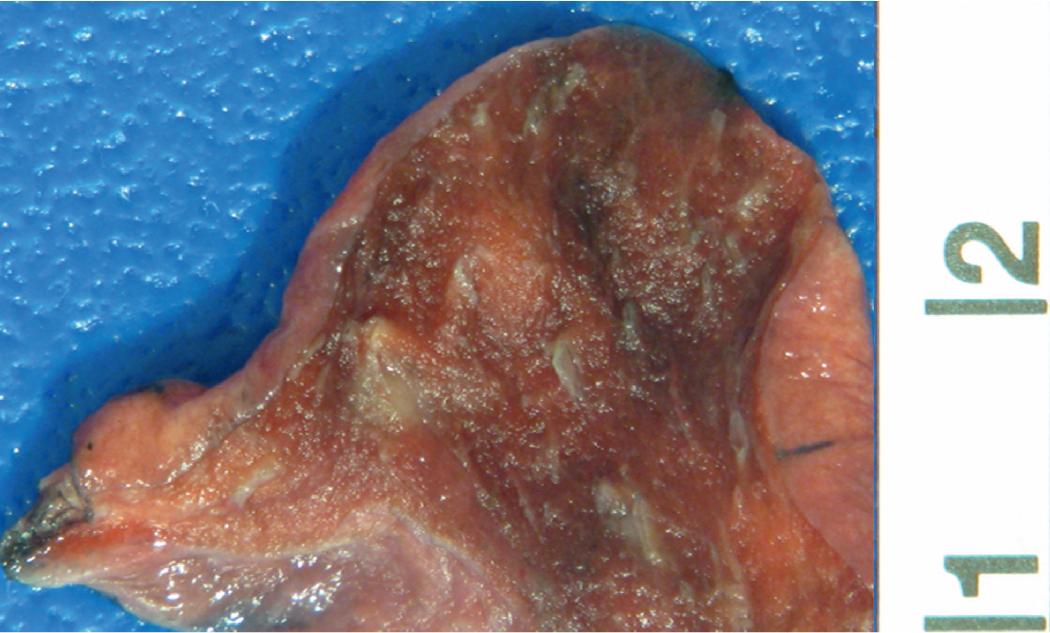
The hallmark of DIPNECH is neuroendocrine cell proliferation in the airway epithelium. The neuroendocrine cells are relatively uniform and can be round, oval, or spindled. Their cytoplasm can be pale and eosinophilic or relatively clear. Their distribution is variable. The patterns of growth can include single cells that are increased in number, aggregates of cells, and confluent expansions lifting overlying respiratory epithelium ( Fig. 14.2 ). These proliferations can be sufficiently exuberant as to cause small aggregates and intraluminal projections ( Fig. 14.3 ). When the cells extend and invade the underlying basement membrane of the epithelium extending into the airway wall, the eccentric nodularity is a carcinoid tumorlet ( Fig. 14.4 ). Carcinoid tumorlets are defined as being less than or equal to 5.0 mm (measured radially not longitudinally); once such nodular proliferations exceed 5.0 mm, they are defined as carcinoid tumors. In practice, tumorlets are morphologically different than carcinoid tumors, with nests of neuroendocrine cells divided up by delicate bands of fibrosis. Carcinoid tumors, on the other hand, are more confluent in their growth pattern.
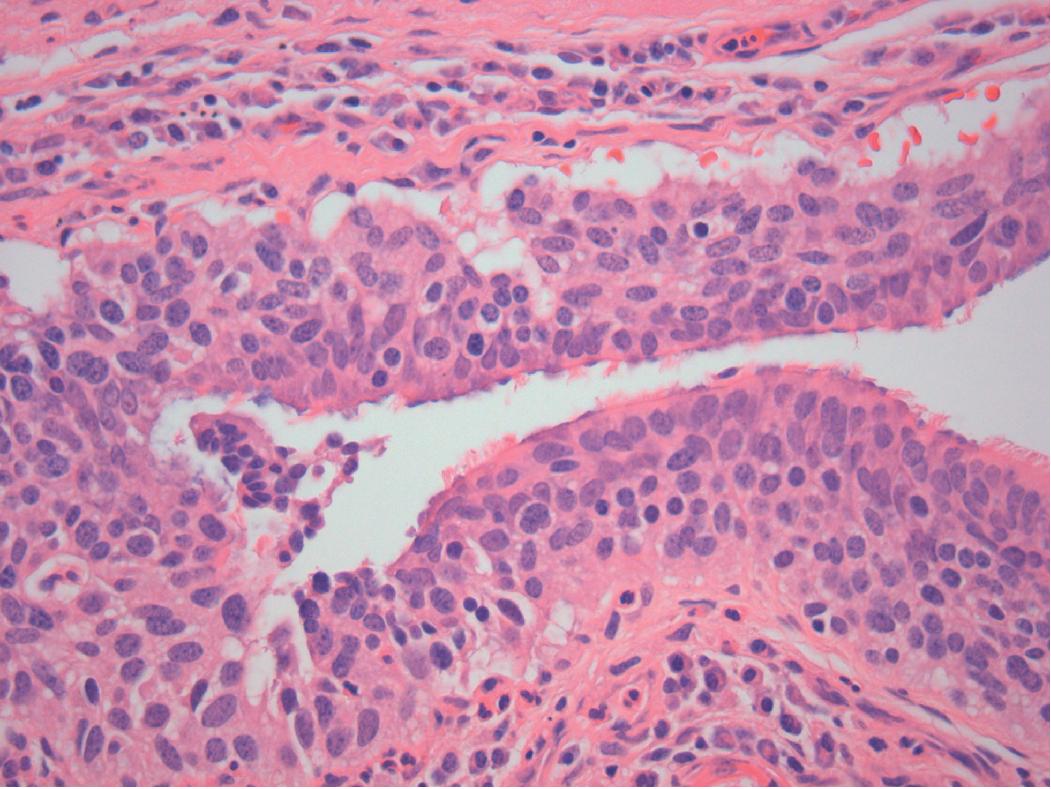
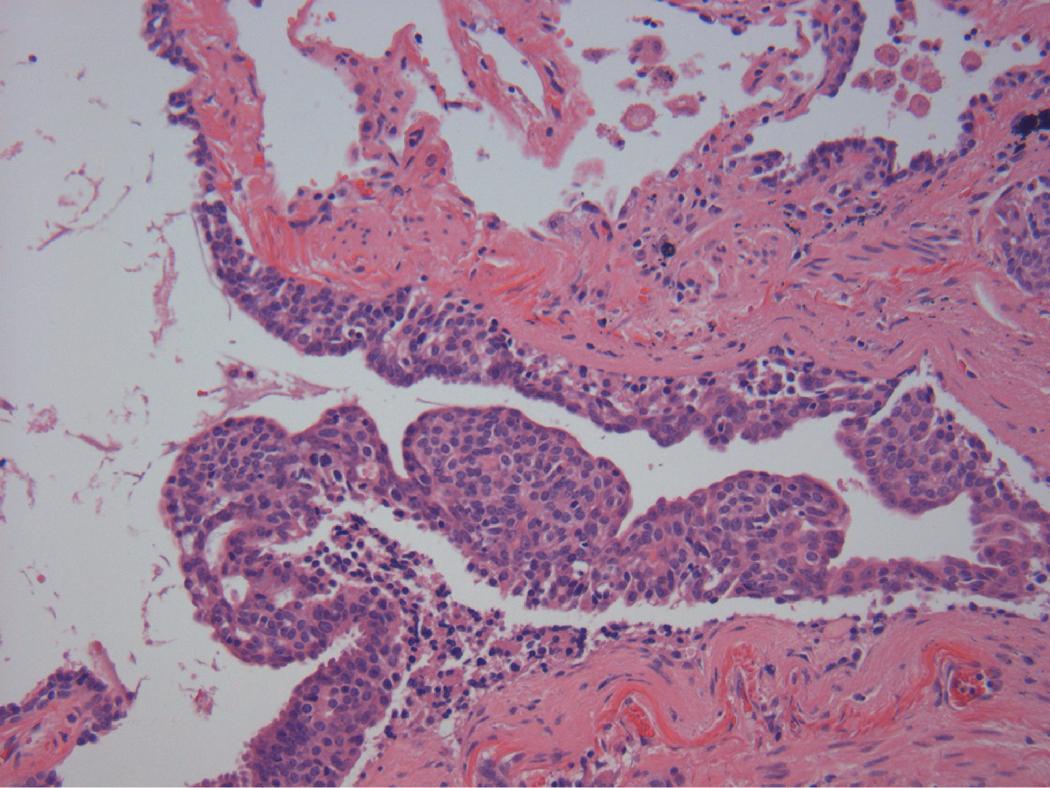
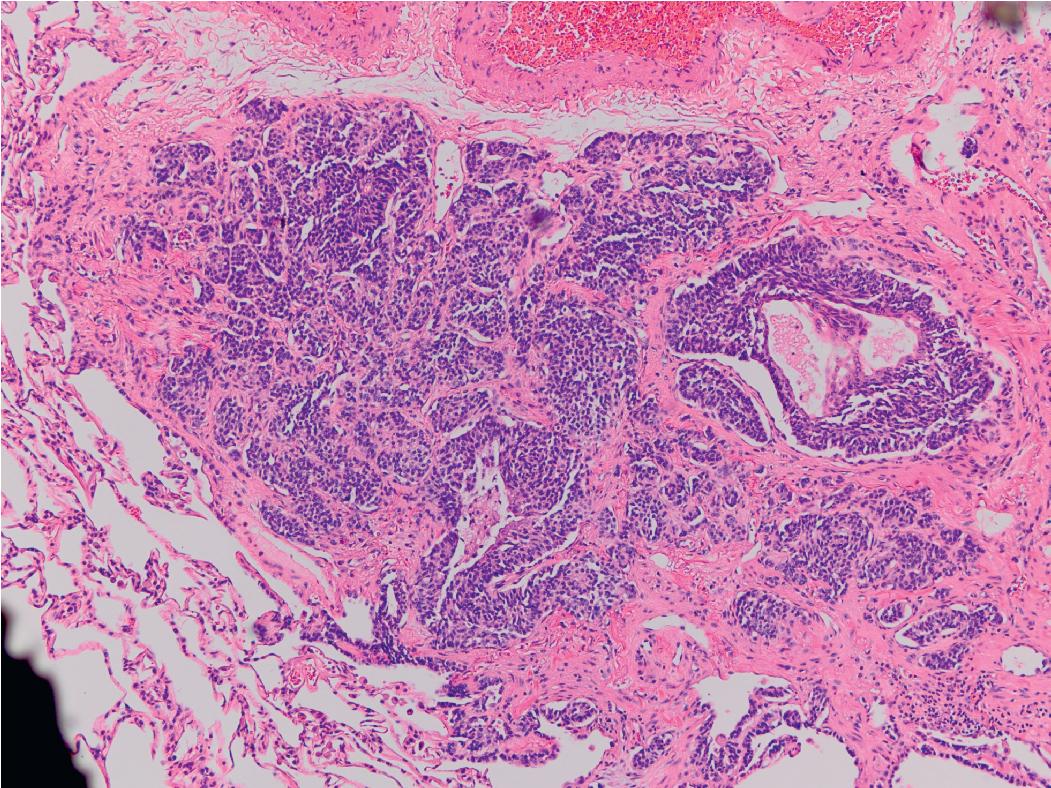
A significant proportion of cases of DIPNECH will have associated carcinoid tumorlets. An additional finding that can be observed is the presence of airway wall scarring, which can be significant, warranting a designation of constrictive bronchiolitis. This fibrosis can be in airways with DIPNECH or in adjacent airways without proliferation. However, a wide spectrum of airways findings has been reported, including airway dilatation, mucous plugging, airway inflammation, and airway wall fibrosis. In some cases, fibrosis was fairly focal, although in others it was multifocal and obliterative.
There is a proposal to define criteria of at least five neuroendocrine cells in a minimum of three bronchioles associated with three or more carcinoid tumorlets. This minimum definition has not been fully tested, so it is not yet adopted , in the current WHO classification. In addition, however, the histologic finding of constrictive bronchiolitis has been introduced as a desired criterion in the current classification.
Although serum chromogranin A, serum serotonin, and urinary 5-hydroxyindolacetic acid levels can be increased, these findings are not sufficiently sensitive to warrant use in the diagnosis of DIPNECH in lieu of tissue sampling.
The cells of DIPNECH are sometimes relatively inapparent and can be mistaken for airway basal cells or inflammatory cells. As a result, immunohistochemical markers can be useful to highlight the proliferation; these can include INSM1, chromogranin A, synaptophysin, or CD56 ( Fig. 14.5 ). In relatively normal lung tissue biopsies in patients with severe obstructive lung disease, IHC may be a useful adjunct to avoid under-diagnosis.
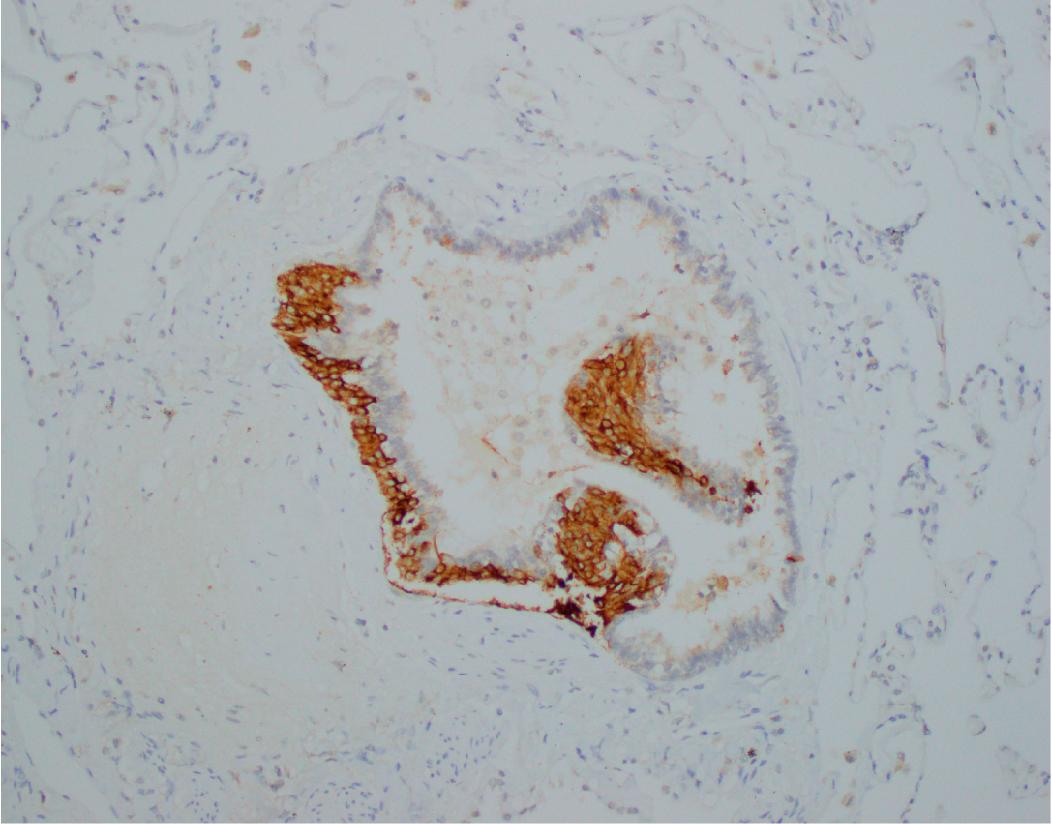
DIPNECH is a preinvasive lesion.
The histology of neuroendocrine cell hyperplasia in association with a variety of chronic lung diseases is the same as that of DIPNECH. Therefore, the multifocality of the lesions, clinical presentation, and imaging need to be combined to confirm a DIPNECH diagnosis. As a result, small samples, such as transbronchial biopsy, might demonstrate neuroendocrine cell hyperplasia, but without evidence of multifocality histologically, this observation needs to be evaluated in the context of clinical and radiologic findings.
Little is known about the genetics of DIPNECH.
In a summary of 55 patients with DIPNECH in whom follow-up was available, 62% had stable disease, although 27% had progressive disease with worsening pulmonary function. Mortality in that review series was unrelated to disease. In a review of 17 patients with clinical follow-up, 76% of patients had either stable disease or showed improvement; a subset of these patients were treated with inhaled corticosteroids and bronchodilators. Somatostatin analog therapy in patients in whom progression occurs and in whom there are hormonal manifestations has been tried with reported success. , In some patients symptomatic improvement (cough) was reported. , Lung transplantation may be an option in patients with severe obstructive lung disease. , Two series reported a death due to progressive lung disease. ,
Although DIPNECH is considered a preinvasive condition, this is based on the similar appearance of the cells in these lesions to those of carcinoid tumor, the presence of carcinoid tumorlets, and the finding of DIPNECH in association with carcinoid tumor resections. In fact, considering the stability of DIPNECH in most patients, subsequent NETs in these patients is only rarely reported. It has been noted that the frequency of neuroendocrine hyperplasia is higher in lungs harboring NETs when compared to nonneuroendocrine tumors and was the highest in carcinoid tumors. It does not appear to predispose or progress to high grade neuroendocrine carcinoma.
Carcinoid tumors are neuroendocrine malignant neoplasms defined by histologic features associated with neuroendocrine differentiation, a low mitotic rate of less than two mitoses per 2 mm 2 (10 HPF) and the absence of necrosis. In the first AFIP fascicle authored by Avril Liebow these tumors were called bronchial adenoma, carcinoid type with suggested commonality with bronchial glands and ducts; however, there was some recognition of their similarity to carcinoid tumors of the ileum. The identification of a relationship of carcinoid tumor cells to neuroendocrine cells led to synonyms such as Kulchitsky cell tumor, argentaffin tumor, well-differentiated neuroendocrine carcinoma, and Grade 1 neuroendocrine carcinoma. Although these latter terms acknowledge their malignant potential (albeit low grade), these terms are not recommended by the IASLC/WHO lung tumor classification system. It is recognized that the NET terminology, as applied to lung, would be well differentiated, grade 1 (G1 NET).
Analysis of the SEER registry in the United States from an 8-year period during the 1990s identified an incidence rate of carcinoids of the lung and bronchus at 0.45 per 100,000, comparable to the rate in the small intestine. A subsequent study has shown a consistent increase in incidence, with 1.4 per 100,000 having been reached in 2003. , It has been proposed that the rate is currently as high as 2.0 per 100,000 with a rate of increase of 3% to 6% per year. The peak age for this tumor is in the fourth to sixth decade of life, with a lower age of presentation for typical carcinoids than atypical carcinoids. , A female predominance is noted, although the female to male ratio varies, up to 2:1. , , The incidence of pulmonary carcinoids is highest in Caucasian populations. Smoking does not increase risk in either men or women, and alcohol ingestion does not increase carcinoid risk. A family history of cancer, not specifically of carcinoid tumor, however, imparts a higher risk of carcinoid tumor.
Carcinoid tumors are the most common pulmonary neoplasm in children and adolescents. The majority are centrally located typical carcinoids, and conservative lung sparing excisions are recommended in these patients. However, as many as 30% have a peripheral location.
Although most carcinoid tumors are sporadic (>95%), some patients have carcinoid tumor is the setting of the MEN 1 syndrome.
Many patients with typical carcinoids are asymptomatic and the tumor is identified incidentally; this rate varies by clinical series in which half to all patients are symptomatic. When symptoms are present, they are usually related to large airway irritation such as cough or wheezing, and in some patients, hemoptysis. Obstruction of the airway can lead to atelectasis and pneumonia.
Neurosecretory symptoms in carcinoids of the lung occur with lower frequency than in tumors of the gastrointestinal tract. Cushing syndrome, , carcinoid syndrome (usually in patients with liver metastasis), and acromegaly can occur; in carcinoid syndrome, this can be associated with an adverse outcome. Pulmonary carcinoid tumors represent a significant proportion of ectopic Cushing syndrome cases, and overall account for 1% of all Cushing syndrome patients.
In patients with a biochemical/endocrine syndrome, laboratory testing may include 24-hour urinary 5-hydroxyindoleacetic acid (carcinoid syndrome), serum cortisol, adrenocorticotropic hormone level, and 24-hour urinary cortisol (Cushing syndrome). In cases of acromegaly, serum growth hormone, growth hormone releasing hormone, or insulin-like growth factor 1 can be measured.
Chromogranin A serum levels can be measured at diagnosis, and these levels can be used to monitor for recurrence postoperatively.
Although carcinoid tumors can be identified on chest x-ray, CT scan is the gold standard. High resolution CT can be used, and contrast enhancement on CT can be exploited because of the high vascularization of these tumors. , They are usually round or ovoid with a smooth contour; they are generally slow growing. Calcification, nodules with hyperlucency, atelectasis, or bronchiectasis can be associated findings.
For staging purposes, imaging of the chest and abdomen should be performed.
Somatostatin receptor scintigraphy may be more sensitive at the determination of stage in carcinoid tumors, and can help identify a primary tumor. Although sensitive, it is of note that other tumors, including carcinomas, may be positive. It has been proposed that fludeoxyglucose (FDG) positron emission tomography (PET) may be able to distinguish carcinoid tumors from atypical carcinoids with higher proliferation rates; this technique may be most helpful in distinguishing carcinoids from high-grade NETs such as small cell or LCNECs.
The sensitivity of FDG-PET in detection of nodal disease in typical carcinoid is low. N2 nodal disease does not preclude surgery but a mediastinal dissection as part of the surgical resection of the primary tumor should be performed even in FDG-PET negative cases. In individual patients in which N2 nodal status would influence surgical decisions, preoperative nodal sampling (e.g., endobronchial ultrasound guided sampling) could be warranted. Octreotide single photon emission computed tomography and other novel imaging techniques such as gallium-labeled somatostatin analogues may be more sensitive at disease detection. ,
In patients with carcinoid syndrome, echocardiography is needed to assess both right- and left- sided valves; left sided valvular disease should be evaluated if the syndrome is seen in the absence of liver metastasis.
Carcinoids are found in the large conducting airways including trachea and bronchi. Central location is more common, although peripheral location is seen in up to 30% of cases. By definition carcinoid tumors are larger than 5.0 mm.
Bronchial carcinoids are, as the name implies, bronchial wall based and can protrude to varying degrees into the bronchial lumen. They are often covered by bronchial epithelium in a dome-like protrusion. The cut surface varies from tan to yellow tan ( Fig. 14.6 ). Carcinoid tumors can also be peripheral where they are often round rather than spiculated. Multicentric forms of carcinoid tumor (not carcinoid tumorlets, which are often multiple) are reported at a rate of about 5%.
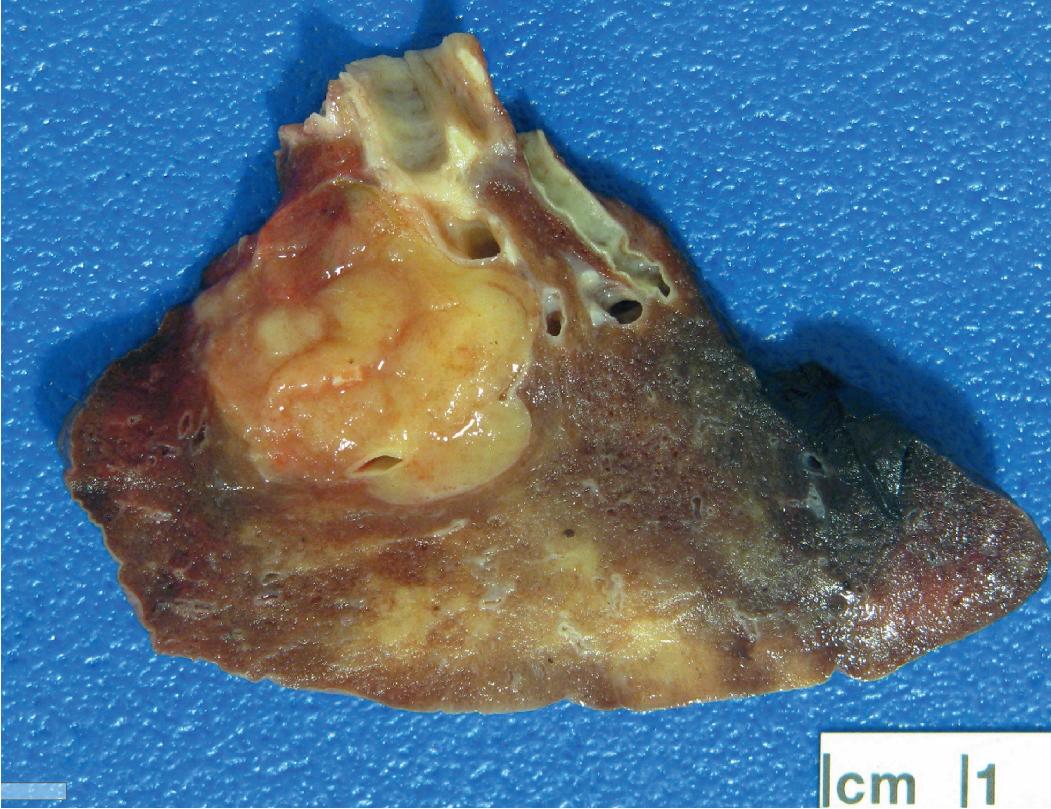
Of resected carcinoids, the majority (75%‒80%) are typical carcinoids. In one series, small sample diagnosis misclassified carcinoids as small cell or nonsmall cell carcinomas in 10% of bronchoscopic biopsy or cytology, and in 43% of peripheral tumors in which adenocarcinomas were the reported but incorrect diagnosis. It is unclear whether ancillary studies were routinely performed in this series.
The classic cytologic features of carcinoid tumors include loose clusters and scattered uniform cells with low to moderate amounts of cytoplasm. Nuclear features are critical; nuclei are round to ovoid, uniform and smoothly contoured, with salt-and-pepper-type chromatin ( Fig. 14.7 ). Nucleoli are absent or inconspicuous, and necrosis is absent. Mitoses should be rare if identified at all. In challenging cases, errors in diagnosis are caused by cellular smears, hyperchromatic nuclei, presence of small nucleoli, and micro-glandular arrangements. The presence of macronucleoli should suggest a different diagnosis such as poorly differentiated carcinoma.
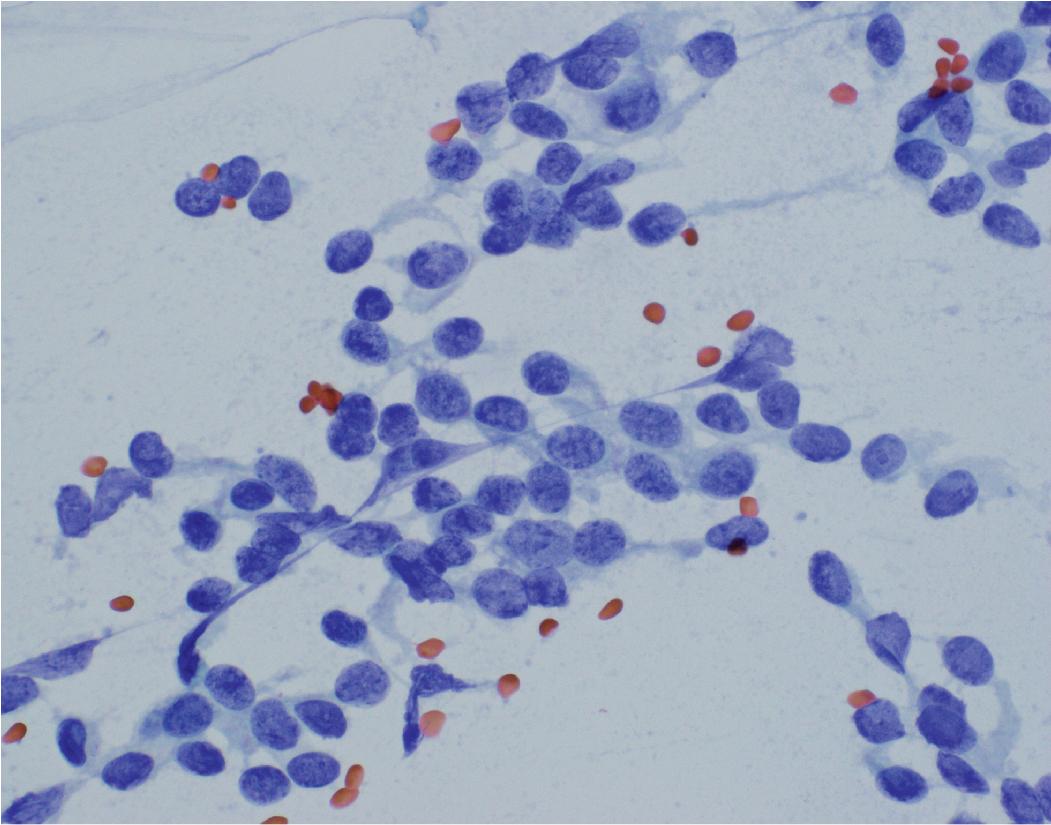
The histology of typical carcinoid tumors includes characteristics associated with neuroendocrine morphology, which encompass architectural and cytomorphologic features. The cells of typical carcinoid have nuclear uniformity with generally round nuclei with smooth nuclear contour ( Fig. 14.8 A). The chromatin is described as salt and pepper (i.e., the chromatin is relatively uniform, without prominent chromocenters, or nucleoli) and without a vesicular chromatin in the background. Although this is seen in the majority of cells, individual cells can be larger and show small nucleoli ( Fig. 14.8 B). In some instances, the nuclei will be ovoid or elongated, and this may be seen with cellular elongation in spindle cell carcinoids ( Fig. 14.8 C). Although spindle cell carcinoids may be more often atypical, spindle cell histology does not equate with atypical carcinoid (i.e., mitotic rate or necrosis criteria must be met). A moderate amount of cytoplasm is seen in most tumors, although more abundant cytoplasm is a feature of oncocytic tumors ( Fig. 14.8 D). Despite a wide variety of architectural patterns, the uniformity of the cells is the most striking feature among these tumors and within a particular tumor.
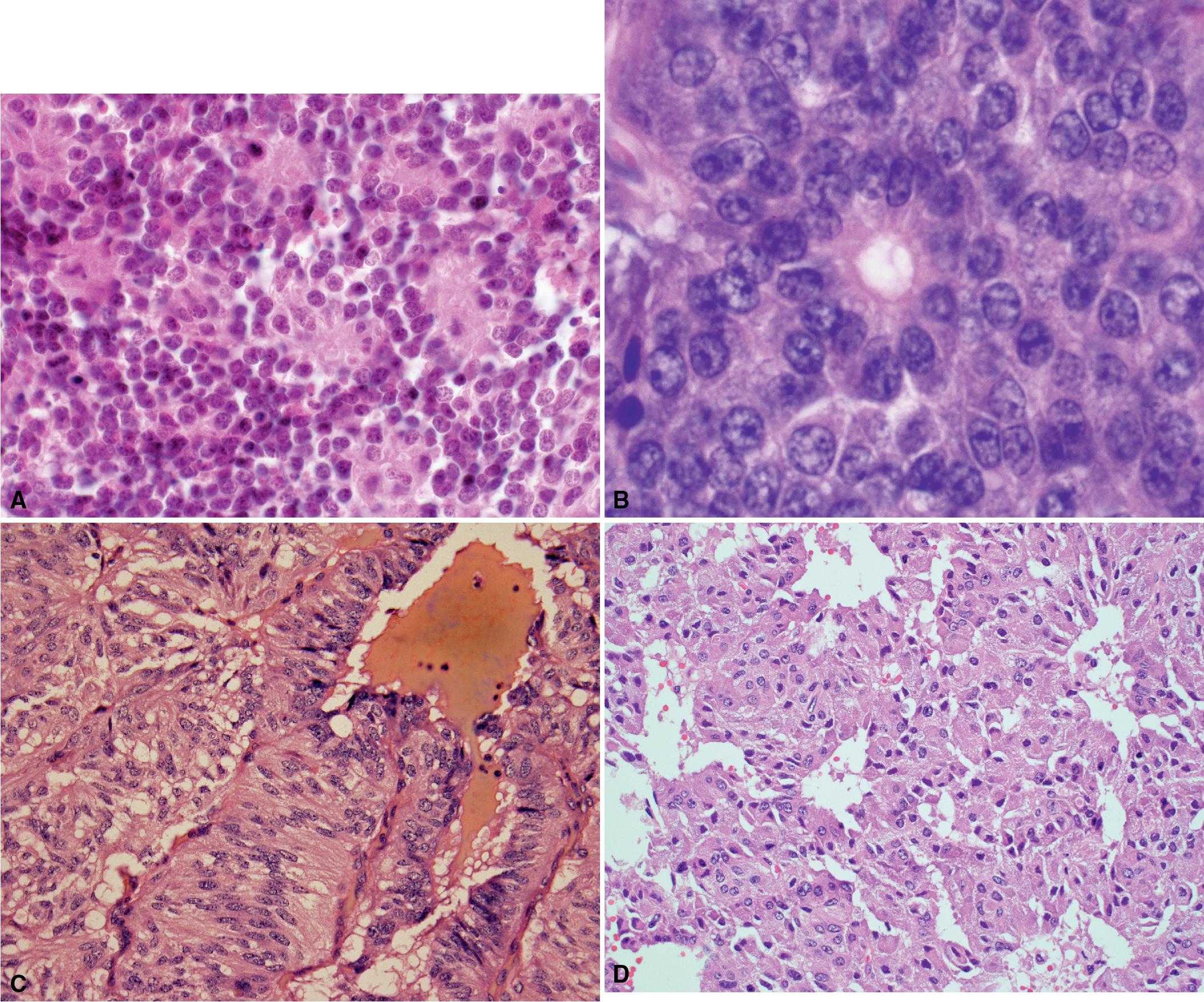
The architecture of carcinoids can be quite varied, even within the same tumor. The classic description is an organoid pattern (i.e., solid islands of cells with an intervening vasculature or delicate stroma [ Fig. 14.9 A]). However, carcinoid patterns can be solid, trabecular ( Fig. 14.9 B), gland-like, and rosette (see Fig. 14.8 A,B) forming; their stroma can be fibrous, calcified, ossified, or amyloid containing ( Fig. 14.9 C).
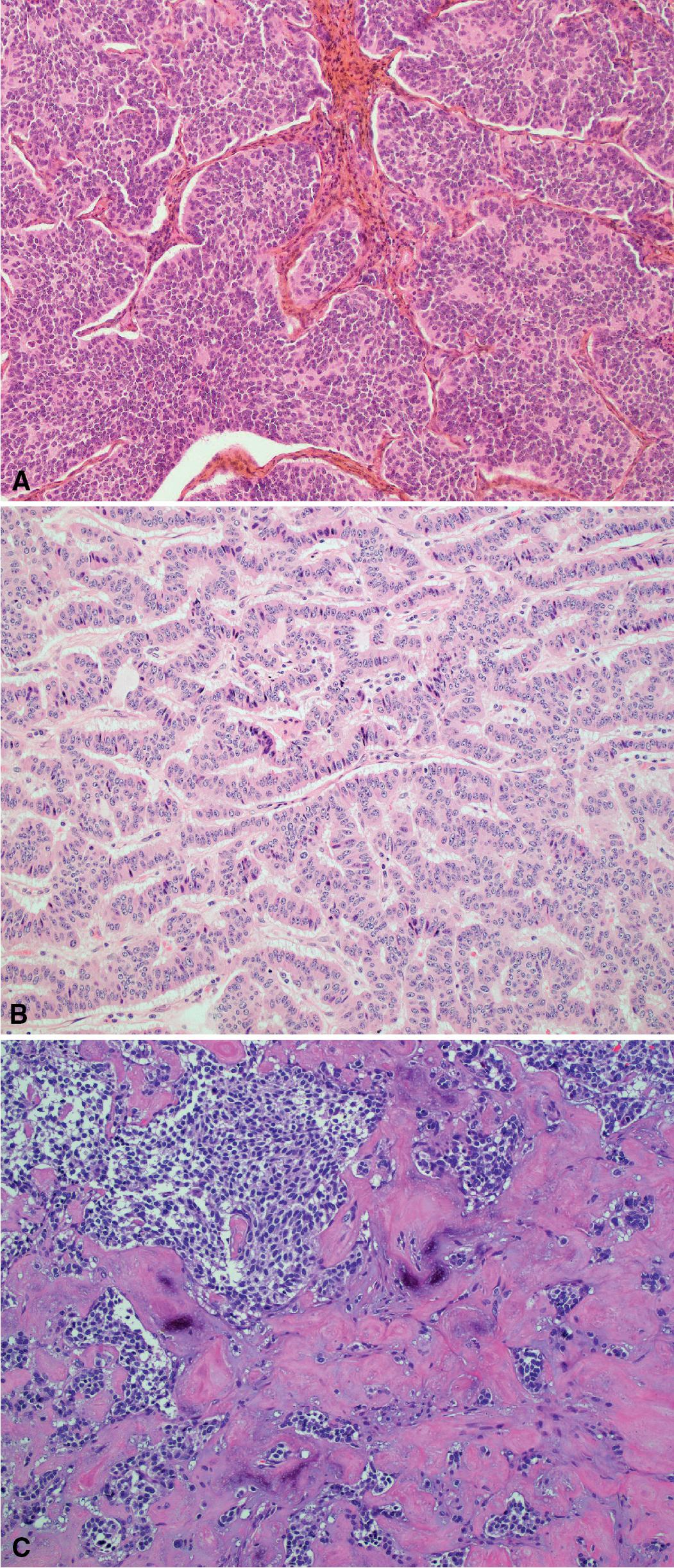
Once neuroendocrine cytology and architecture are confirmed, specific histologic features are required to designate a tumor as typical carcinoid. There should be no necrosis. In addition, mitotic rate is low; this is less than two mitoses per 2 mm 2 ; this field size represents an attempt to standardize 10 high power field (HPF) across different microscopes. Despite the difficulty in determining field size, a more challenging problem in mitotic figure counting is the selection of hot-spot fields. In this regard, the cutoff of less than two mitoses is inclusive of some tumors in which two or three mitoses are identified within one set of fields but not others. This could lead to an atypical carcinoid designation dependent on the numbers of total fields counted per case. This was confirmed by Tsuta et al. with atypical carcinoids that were “overcalled” when counting only one set of 10 HPF or 2.0 mm 2 , which would have been deemed typical using an average or mean approach.
With this problem in mind, the 2021 WHO/IASLC classification recommends that cases with counts on the cusp of the cutoff be analyzed for three sets of 2 mm 2 requiring an average number equal to or greater than required for atypical carcinoid. This has now been incorporated into language that advocates average counts over that of hot-spots so that one set of fields over the count of two does not preclude the diagnosis of typical carcinoid. With these caveats in mind, from a practical point of view, the counting of at least three sets of fields to achieve an average rate that is two or over addresses the situation in which the very stringent cutoff of two mitoses in 2 mm 2 is reached focally within what is otherwise a typical carcinoid.
Other points in the evaluation of mitoses include using fields of similar cellularity and including only definitive mitoses. In small samples, sufficient numbers of fields may not be available for review. If mitoses cannot be reliably counted and necrosis is absent, the classification of a carcinoid may have to remain carcinoid or not otherwise specified (NOS). In metastatic sites, mitotic counting is not recommended to distinguish typical from atypical carcinoid, and the term metastatic carcinoid is recommended.
Margin assessment in carcinoid tumors is critical, but an optimal distance has not been determined. In one series, recurrences were not seen if margins exceeded 1.0 cm, but at less than 2.0 mm recurrences did occur.
Although IHC is not required for the diagnosis of typical carcinoid, the difference in biologic behavior between these tumors and what is in their differential diagnosis often warrants additional testing. Neuroendocrine markers may be helpful as these tumors should be positive for one or more neuroendocrine markers, and often have diffuse strong reactivity. These markers can include INSM1, synaptophysin, chromogranin, or CD56. Overall, chromogranin is the most specific and least sensitive neuroendocrine marker, with synaptophysin with greater sensitivity and reduced specificity and CD56 with the greatest sensitivity. Of note, CD56 is the least specific, as noted in the chapter introduction. In carcinoids, the performance of INSM1 has been compared and is more sensitive than chromogranin and has similar specificity.
Given the importance of ASCL1 in neuroendocrine cell development, this target has been proposed as a potential neuroendocrine marker when comparing tumors to squamous cell and adenocarcinoma. ASCL1 staining was seen in all NETs, independent of grade, but not in other lung carcinomas in their differential diagnosis.
Cytokeratin can be useful in the diagnosis of carcinoid. However AE1:AE3 cytokeratin cocktail does not stain a significant proportion of carcinoids (25%‒30% are negative), and low-molecular-weight keratin such as CAM5.2 may be needed to highlight these cases. Thyroid transcription factor 1 (TTF1) may be helpful in the determination of a pulmonary origin for a carcinoid tumor at advanced stage; in addition, TTF1 may be more frequently positive in peripheral carcinoids. , Other markers such as napsin A, p40, p63, and CK5/6, which may be used in nonsmall cell carcinoma classification, are negative in carcinoid tumors. PAX8, which has been described as a marker of pancreatic and nonileal gastrointestinal endocrine tumors, is negative in pulmonary carcinoids.
Ki-67 has been proposed as an important adjunct in the classification of carcinoids. In the setting of a small sample, especially one with crush artifact, a low Ki-67 may indicate a carcinoid tumor (typical or atypical) rather than a small cell carcinoma, and a high Ki-67 (>30%) may make a carcinoid tumor unlikely. , This may avoid a misclassification, which could have direct impact on the treatment strategy for a particular patient. Although broad Ki-67 cutoffs, as noted above, separate the low-grade from the high-grade NETs, routine use of Ki-67 in the differential diagnosis of typical carcinoid from atypical carcinoid requires further validation of clinically relevant cutoffs. Continued interest in Ki-67 scoring stems from the promise of improvement in interobserver agreement when compared to mitotic counting.
In one series, atypical carcinoids had a higher average Ki-67 count, but there was overlap with typical carcinoids. Using an automated approach to Ki-67 index, an upper limit cutoff of 7% corresponded to typical carcinoids. In a review of prior series, Pelosi et al. describe a lack of uniform methodology towards measuring Ki-67 index, and varied cutoff values for disease categories. A proposal for a lung-specific methodology has been published, which will require further validation before it can be adopted into the future classification of carcinoids.
The role of Ki-67 in the prognostication of pulmonary carcinoids has been investigated. Although in univariate analysis a cutoff of 5% has been identified as predictive of survival, this was not independent of histologic classification. Therefore evidence of independent use of Ki-67 in lieu of histology was not supported in that series. More recently, it has been suggested that a Ki-67 of more than 5% in typical carcinoids predicts recurrence.
In pulmonary carcinoid tumors, the classification system designates typical carcinoids as low grade. In addition, histologic subtype is of equal if not greater importance than stage. ,
The majority of typical carcinoids are Stage 1a. , Although nodal disease occurs at a rate of about 10% to 5%, most series show N1 involvement more frequently than N2 involvement. However, increasing use of systematic nodal dissection may increase the rate of N2 detection. In some cases, N2 involvement occurs in the absence of N1 involvement. Tumor, node, metastasis (TNM) staging is associated with survival, and 10-year disease specific survival decreases with increasing stage group, including with positive nodal status. , It has been noted that within stage groups, overlaps exist in outcome prediction by stage.
Spindle cell carcinoids are more often peripherally located. Although they share the nested patterns with fine vascularity of other carcinoids, the cells themselves are uniform elongated spindle cells. Although they can mimic low-grade smooth muscle tumors, they do not have the interlacing bundles of cells alternating with longitudinal and transverse. Their chromatin is uniform as in other carcinoids. In early series they were equated with atypia but it is now recognized that the criteria for atypia (mitoses, necrosis) are the same as for classic carcinoids. Oncocytic carcinoids are characterized by abundant eosinophilic cytoplasm which ultrastructurally represents increased numbers of mitochondria. It has been suggested that this variant may be especially PET avid. There are variants with abundant sclerosis but without amyloid in the stroma; these tumors can be diagnostically challenging because the lesional cells are relatively sparse. This can be especially difficult in small samples; they are otherwise typical carcinoids by biologic behavior. Some carcinoids can have clear cells and rarely melanin pigment can be seen. In addition to sclerotic stroma, carcinoids can have amyloid-like stroma as well as prominent stromal mucin.
Metastatic carcinoid tumors from other organs (NETs), such as those from the gastrointestinal tract, can be seen in the lung. There has been interest in IHC for several markers in this setting, such as TTF1, caudal type homeobox 2 (CDX2), and insulin gene enhancer protein (ISL1) to distinguish tumors of lung, small intestine, and pancreas, an approach that has moderate sensitivity and high specificity. In addition, homeobox protein orthopedia (OTP) has been examined in several studies, both in biopsy and cytology specimens, with sensitivity of 80% and high specificity for carcinoid tumors of pulmonary origin. , In suboptimal specimens with crush artifact, especially in metastatic sites, carcinoid tumors can be confused with small cell carcinoma, and Ki-67 can be helpful in this setting.
Because of the uniformity of the cells, tumors of bronchial minor salivary gland origin such as mucoepidermoid carcinoma with prominent intermediate cells can be confused with carcinoid tumor. Metastatic breast carcinoma, especially lobular carcinoma and those with solid growth pattern can be confused with carcinoid. Plasma cell neoplasms, especially on frozen section (and with amyloid-like stroma) can be quite difficult to distinguish from carcinoid tumors; fortunately this situation is uncommon. Although very rare in the lung, paragangliomas can be very similar histologically to carcinoid tumors. Finally, glomus tumors can have monotonous appearance and given their rarity in lung, can be mistaken for the relatively more common carcinoid tumor. Their immunoreactivity for smooth muscle actin and lack of neuroendocrine markers should resolve this differential diagnosis.
Carcinoid tumors have demonstrated allelic imbalance in 11q13 in the region of the MEN1 gene. MEN1 gene mutations and loss of expression are seen. , These 11q deletions are seen in both typical and atypical carcinoids but generally not in small cell carcinomas or LCNECs. Additionally, this region includes the SCGB1A1 gene which is also known as club cell specific protein or uteroglobin. Losses of 10q and 13q are less common in typical than atypical carcinoid. Losses in 3p are uncommon in typical carcinoids, and losses of 5q that are common in carcinomas are uncommon in carcinoid tumors. These findings argue against a transition of low and intermediate grade tumors into high grade tumors.
Mutations and gene expression in carcinoids are distinct from that of small cell carcinoma in that TP53 and RB1 mutation and loss of function are quite rare in carcinoid tumors. , Mutations and deletions in MEN1 are seen in carcinoids not carcinomas, but those in the SWI/SNF complex (ARID1A, ARID2, SMARCA4, ACTL6A, ACTL6B) are reported in both carcinoids and carcinomas. , , Overall, these are low tumor mutation burden tumors. Pathways shown to be altered by gene expression include NF-kB and MAPK/ERK pathways.
This has led to suggestions that there are molecular subtypes of carcinoid tumors. One series describes 3 categories, which they divided as LC1, LC2, and LC3. The LC3 category were central, in younger patients, and contained only typical carcinoids, LC2 contained the MEN1 loss cases, and LC1 contained peripheral tumors. Although clustering did not separate typical from atypical carcinoids overall, cell cycle genes were more likely expressed in atypical carcinoids. In other series, three clusters were also reported, one of which was characterized by high ASCL1 and DLL3, one by mutations in EIF1AX and the third by MEN1 mutations and a poorer prognosis. Although the diagnostic, prognostic, and therapeutic implications of these clusters remain unknown, it may suggest distinct cells of origin or distinct cellular differentiation states in these tumors.
Become a Clinical Tree membership for Full access and enjoy Unlimited articles
If you are a member. Log in here